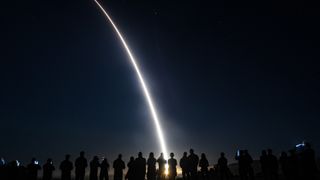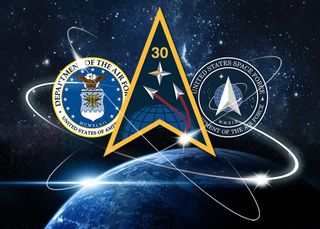US launches unarmed ballistic missile from Vandenberg Space Force Base
The unarmed ICBM carried three undisclosed reentry vehicles.

The U.S. Air Force conducted an early-morning suborbital test of an unarmed Minuteman III intercontinental ballistic missile, or ICBM, on Wednesday (Sept. 7).
Air Force Global Strike Command launched the ICBM from Vandenberg Space Force Base in California at 1:13 a.m. PT (4:13 a.m. ET; 0913 GMT). The test was conducted to "validate and verify the safety, security, effectiveness and readiness of the weapon system," according to a Space Force statement.
The Minuteman III ICBM carried three undisclosed test reentry vehicles, according to a Space Force video released following the test. A reentry vehicle is the payload of an ICBM that reenters the atmosphere following a launch, typically a nuclear warhead, although hypersonic glide vehicles will surely become common reentry vehicles as they continue to be developed. The missile traveled 4,200 miles (6,759 kilometers) at hypersonic speeds reaching 15,000 mph (24,140 kph), or about 4 miles (6.4 km) per second.
Related: Atlas V rocket launches classified missile-tracking satellite for US Space Force
The missile fired in the test launch was chosen at random from a stockpile at F.E. Warren Air Force Base in Wyoming, disassembled and shipped to Vandenberg, where it was reassembled prior to launch. These tests are typically planned years in advance, and pre-launch notifications were sent to the Russian government in accordance with the New START arms control treaty.
Col. Bryan Titus, Space Launch Delta 30 vice commander, said in the statement that these launches "demonstrate the readiness of U.S. nuclear forces and provide confidence in the lethality and effectiveness of the nation's nuclear deterrent."
Space Launch Delta 30 oversees all launches from the U.S. west coast, including those that place satellites into polar orbits. "The Airmen and Guardians who perform this vital mission are some of the most skillfully trained and dedicated personnel in America's Air and Space Force," Titus added.
Get the Space.com Newsletter
Breaking space news, the latest updates on rocket launches, skywatching events and more!

Netherlands-based satellite tracker Marco Langbroek shared images via Twitter of the navigational warnings issued prior to the launch that depict the ICBM's path from Vandenberg to the Ronald Reagan Ballistic Missile Defense Test Site in the Kwajalein Atoll in the Marshall Islands.
The Minuteman III, or LGM-30G, was first deployed in 1970 and is scheduled to be phased out by 2030 and replaced with the upcoming LGM-35A Sentinel ICBM currently under development.
Follow Brett on Twitter at @bretttingley. Follow us on Twitter @Spacedotcom or on Facebook.
Join our Space Forums to keep talking space on the latest missions, night sky and more! And if you have a news tip, correction or comment, let us know at: community@space.com.

Brett is curious about emerging aerospace technologies, alternative launch concepts, military space developments and uncrewed aircraft systems. Brett's work has appeared on Scientific American, The War Zone, Popular Science, the History Channel, Science Discovery and more. Brett has English degrees from Clemson University and the University of North Carolina at Charlotte. In his free time, Brett enjoys skywatching throughout the dark skies of the Appalachian mountains.
